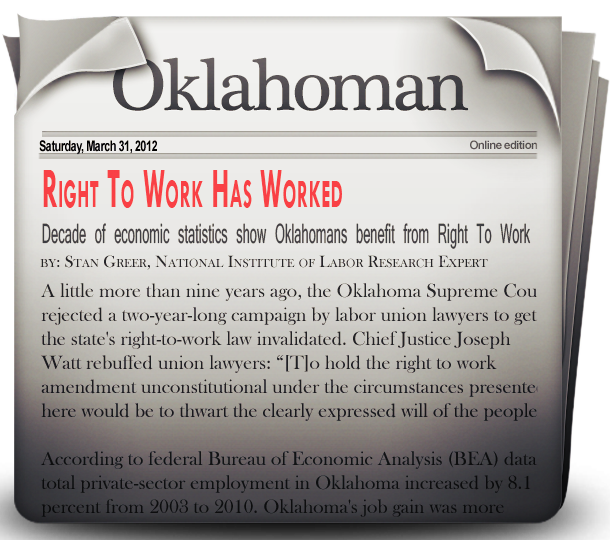Oklahoma Economy Rides the Right to Work Freedom Wave

 Oklahoman Op-Ed by Stan Greer:
Oklahoman Op-Ed by Stan Greer:
A little more than nine years ago, the Oklahoma Supreme Court rejected a two-year-long campaign by labor union lawyers to get the state’s right-to-work law invalidated. Chief Justice Joseph Watt rebuffed union lawyers: “[T]o hold the right to work amendment unconstitutional under the circumstances presented here would be to thwart the clearly expressed will of the people.â€
Oklahomans’ primary aim in putting a right-to-work law on the books was to end a gross imbalance in public policy. Prior to passage of right to work, the law protected each Oklahoma employee’s right to support a union, but at the same time authorized the firing of many employees if they refused to support a union. The right-to-work law makes union dues and fee payments purely voluntary. Moreover, Oklahoma’s economy has flourished since the law was upheld in 2003.
According to federal Bureau of Economic Analysis (BEA) data, total private-sector employment in Oklahoma increased by 8.1 percent from 2003 to 2010. Oklahoma’s job gain was more than triple the average for forced-unionism states (then 28 in number) and more than 60 percent greater than the average for its three non-right-to-work neighbor states — Missouri, Colorado and New Mexico.
Over the same period, inflation-adjusted BEA data show private-sector employer outlays for employee compensation grew by more than 12 percent in Oklahoma. Real private-sector compensation expanded at a rate 13 times the non-right-to-work state average of 0.9 percent, and 3 1/2 times the 3.4 percent aggregate gain for Oklahoma’s non-right-to-work neighbors. Moreover, the direct impact of Oklahoma’s signature oil and gas extraction industry actually accounts for less than 14 percent of its overall real gain in compensation.
In view of such facts, one might expect the Economic Policy Institute (EPI), a “think tank†that is largely funded by Big Labor, would be keeping a discreet silence about Oklahoma nowadays. In 2001, the EPI predicted that 112,000 Oklahomans would lose their health insurance coverage if the right-to-work amendment won approval. In fact, from 2003 to 2010, according to U.S. Census Bureau data, the number of people covered by private, job-based health insurance increased by 7.6 percent in Oklahoma, even as coverage fell in forced-unionism states collectively by 6.5 percent.
EPI continues to ignore the evidence. Recently, it branded the Oklahoma right-to-work law as a “failure†because the state’s manufacturing employment has declined in recent years. In reality, Oklahoma’s BEA-reported drop in manufacturing jobs from 2003 to 2010 was smaller than that of each of its non-right-to-work neighbors and barely half the 19.6 percent decline endured by forced-unionism states collectively!
Many union label politicians want to believe whatever the EPI says about right-to-work laws. The record shows this dubious “think tank†is not to be trusted.

